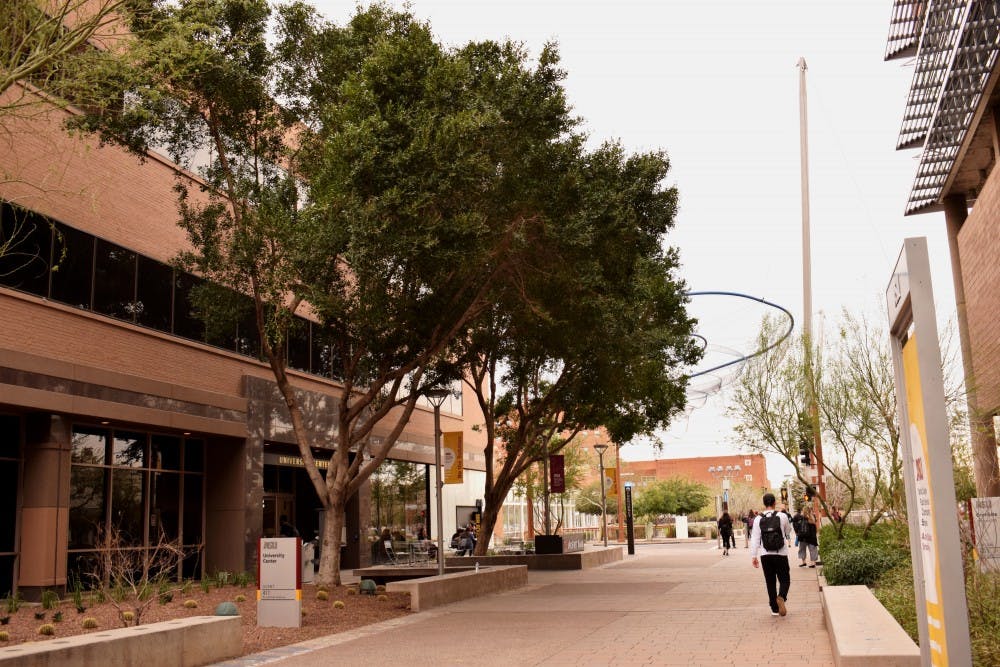Two large ficus trees in front of the University Center building on ASU's downtown Phoenix campus were once home to a large, boisterous bird population, but after the trees were thinned in December 2018, activists are voicing concerns about ASU's landscaping choice.
Local environmental advocacy group The Urban Phoenix Project condemned ASU’s landscaping decision and claimed that students and faculty must learn to accommodate nature, rather than remove it for their convenience.
“Those trees were healthy, and they were doing just fine,” Sean Sweat, president of The Urban Phoenix Project, said. “We should not be hacking apart trees and bushes and other vegetation just to get rid of things.”
The Urban Phoenix Project’s first comment on the thinning dates to late last month, when a Facebook post critiqued the University's choice to thin the trees to “run off” its bird population.
“Urban ecologies are about more than just people," the organization wrote in its Facebook post. "This is a complex world, and we need to be designing out cities so we can share them."
Alana Levine, director of Zero Waste at ASU, said the University does not trim trees just to eliminate wildlife.
ASU’s Tempe campus is a designated tree arboretum, an area devoted to planting trees and shrubs, and is a part of the Tree Campus USA program that aims to build up tree populations and green spaces in major metropolitan areas, Levine said.
Related: ASU arboretum promotes environmental-community engagement
She said the practices that are used by Tempe groundskeepers and arborists to manage the trees responsibly are also used on other ASU campuses.
“We actually do a lot of checks beforehand, and we watch the trees to really understand the ecology of the area,” Levine said. “If there’s nesting, we’ll often delay some tree pruning or go off and delay doing a spot in a tree because we’ve found a nest.”
While the absence of birds on the University Center ficus trees may appear drastic to students and other observers, Levine said that once the trees fill out, they will once again become a welcoming home to downtown Phoenix's birds.
“Those trees are going to fill out faster than we think," Levine said. "It allows new growth. It allows the trees to actually grow a little healthier in these urban settings, and it’ll poof out pretty fast. There’ll be a lot of birds back in that terrain.”
While the ficus trees were the primary concern of The Urban Phoenix Project in its post, there were also concerns written on the group's Facebook page about the hyper-manicuring of ASU’s lawns.
Chingwen Cheng, an assistant professor of landscape architecture, claimed that the University does not do enough to be a sustainable campus, especially due to its landscaping choices, specifically on the Tempe campus.
“All irrigation is from potable water; they don’t even meter to know how much they irrigate,” Cheng said. “We claim to be number one in innovation, and then we claim to be one of the first sustainable schools, so I do want us to think more about the practices in our campus design.”
Read more: ASU and H2O: How the University uses its water
Cheng said creating more eco-friendly landscaping like moving away from large green lawns on ASU campuses could bring students with a more progressive agenda to ASU.
“I hope ASU can draw students (that) can actually create our image as a real sustainable campus," Cheng said. "People come here to learn about what it takes to be a sustainable campus in every walk of life and every decision we make.”
Levine said there is conflict between ASU’s desire to market its campus with large, green lawns and wanting to create more water-resistant landscaping for improved water sustainability. As director, one of Levine's priorities is to move away from non-programmable lawns — a programmable lawn being a lawn used for athletics — and moving toward desert planting.
Sweat said that urban spaces like downtown Phoenix need to work more to incorporate biophilic design, which refers to the practice of creating structures that connect people to nature.
Sweat’s goal is that the increase in the tree canopy will lead to more pedestrian traffic since more trees will mean greater comfort for people who walk and bike in downtown Phoenix. This, Sweat hopes, will lead people to drive less, helping the environment by cutting back on greenhouse gas emissions.
Trees may consume more water than many desert plants, but Sweat said the value they hold by giving people shade will benefit urban areas exponentially.
“We should be thinking about how to integrate these nature elements so that it softens our environment,” Sweat said. “It makes it a place that people do want to stay in more and not just a conduit that people want to bustle through to get to the next place.”
Levine echoed the importance of trees in urban settings, and what they can bring to the ecosystem and people.
“The first impression can be like 'well let’s make everything (cacti) and now we’re sustainable’ when we have to look at how multifaceted sustainability is and come up with the best solution for an area,” Levin said. “We can contribute to all the sustainable goals of landscaping, but it may not look exactly (like) what somebody would conceive of as sustainable landscaping.”
Reach the reporter at tmlane3@asu.edu and follow @tmflane on Twitter.
Like The State Press on Facebook and follow @statepress on Twitter.




